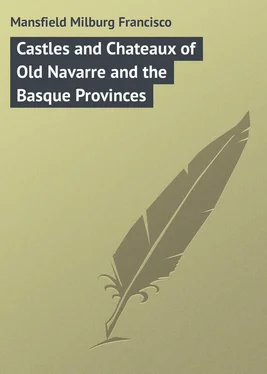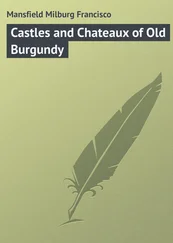Milburg Mansfield - Castles and Chateaux of Old Navarre and the Basque Provinces
Здесь есть возможность читать онлайн «Milburg Mansfield - Castles and Chateaux of Old Navarre and the Basque Provinces» — ознакомительный отрывок электронной книги совершенно бесплатно, а после прочтения отрывка купить полную версию. В некоторых случаях можно слушать аудио, скачать через торрент в формате fb2 и присутствует краткое содержание. ISBN: , Жанр: foreign_prose, на английском языке. Описание произведения, (предисловие) а так же отзывы посетителей доступны на портале библиотеки ЛибКат.
- Название:Castles and Chateaux of Old Navarre and the Basque Provinces
- Автор:
- Жанр:
- Год:неизвестен
- ISBN:http://www.gutenberg.org/ebooks/43609
- Рейтинг книги:4 / 5. Голосов: 1
-
Избранное:Добавить в избранное
- Отзывы:
-
Ваша оценка:
- 80
- 1
- 2
- 3
- 4
- 5
Castles and Chateaux of Old Navarre and the Basque Provinces: краткое содержание, описание и аннотация
Предлагаем к чтению аннотацию, описание, краткое содержание или предисловие (зависит от того, что написал сам автор книги «Castles and Chateaux of Old Navarre and the Basque Provinces»). Если вы не нашли необходимую информацию о книге — напишите в комментариях, мы постараемся отыскать её.
Castles and Chateaux of Old Navarre and the Basque Provinces — читать онлайн ознакомительный отрывок
Ниже представлен текст книги, разбитый по страницам. Система сохранения места последней прочитанной страницы, позволяет с удобством читать онлайн бесплатно книгу «Castles and Chateaux of Old Navarre and the Basque Provinces», без необходимости каждый раз заново искать на чём Вы остановились. Поставьте закладку, и сможете в любой момент перейти на страницу, на которой закончили чтение.
Интервал:
Закладка:
Francis Miltoun
Castles and Chateaux of Old Navarre and the Basque Provinces
By Way of Introduction
“Cecy est un livre de bonne foy.”
Montaigne.No account of the life and historical monuments of any section of the old French provinces can be made to confine its scope within geographical or topographical limits. The most that can be accomplished is to centre the interest around some imaginary hub from which radiate leading lines of historic and romantic interest.
Henri de Navarre is the chief romantic and historical figure of all that part of France bounded on the south by the Pyrenean frontier of Spain. He was but a Prince of Béarn when his mother, Jeanne d’Albret, became the sovereign of French Navarre and of Béarn, but the romantic life which had centred around the ancestral château at Pau was such that the young prince went up to Paris with a training in chivalry and a love of pomp and splendour which was second only to that of François I. The little kingdom of Navarre, the principality of Béarn, and the dukedoms and countships which surround them, from the Mediterranean on the east to the Gulf of Gascony on the west, are so intimately connected with the gallant doings of men and women of those old days that the region known as the Pyrenean provinces of the later monarchy of France stands in a class by itself with regard to the romance and chivalry of feudal days.
The dukes, counts and seigneurs of Languedoc and Gascony have been names to conjure with for the novelists of the Dumas school; and, too, the manners and customs of the earlier troubadours and crusaders formed a motive for still another coterie of fictionists of the romantic school. In the Comté de Foix one finds a link which binds the noblesse of the south with that of the north. It is the story of Françoise de Foix, who became the Marquise de Chateaubriant, the wife of Jean de Laval, that Breton Bluebeard whose atrocities were almost as great as those of his brother of the fairy tale. And the ties are numerous which have joined the chatelains of these feudal châteaux and courts of the Midi with those of the Domain of France.
These petty countships, dukedoms and kingdoms of the Pyrenees were absorbed into France in 1789, and to-day their nomenclature has disappeared from the geographies; but the habitant of the Basses Pyrénées, the Pyrénées Orientales, and the Hautes Pyrénées keeps the historical distinctions of the past as clearly defined in his own mind as if he were living in feudal times. The Béarnais refers contemptuously to the men of Roussillon as Catalans, and to the Basques as a wild, weird kind of a being, neither French nor Spanish.
The geographical limits covered by the actual journeyings outlined in the following pages skirt the French slopes of the Pyrenees from the Atlantic Gulf of Gascony to the Mediterranean Gulf of Lyons, and so on to the mouths of the Rhône, where they join another series of recorded rambles, conceived and already evolved into a book by the same author and artist. 1 1 “Castles and Châteaux of Old Touraine and the Loire Country.”
The whole itinerary has been carefully thought out and minutely covered in many journeyings by road and rail, crossing and recrossing from east to west and from west to east that delectable land commonly known to the Parisian Frenchman as the Midi.
The contrasts with which one meets in going between the extreme boundaries of east and west are very great, both with respect to men and to manners; the Niçois is no brother of the Basque, though they both be swarthy and speak a patois , even to-day as unlike modern French as is the speech of the Breton or the Flamand. The Catalan of Roussillon is quite unlike the Languedoçian of the Camargue plain, and the peasant of the Aude or the Ariège bears little or no resemblance in speech or manners to the Béarnais.
There is a subtle charm and appeal in the magnificent feudal châteaux and fortified bourgs of this region which is quite different from the warmer emotions awakened by the great Renaissance masterpieces of Touraine and the Loire country. Each is irresistible. Whether one contemplates the imposing château at Pau, or the more delicately conceived Chenonceaux; the old walled Cité of Carcassonne, or the walls and ramparts of Clisson or of Angers; the Roman arena at Nîmes, or the Roman Arc de Triomphe at Saintes, there is equal charm and contrast.
To the greater appreciation, then, of the people of Southern France, and of the gallant types of the Pyrenean provinces in particular, the following pages have been written and illustrated.
F. M.Perpignan, August , 1907.
CHAPTER I
A GENERAL SURVEY
THIS book is no record of exploitation or discovery; it is simply a review of many things seen and heard anent that marvellous and comparatively little known region vaguely described as “the Pyrenees,” of which the old French provinces (and before them the independent kingdoms, countships and dukedoms) of Béarn, Navarre, Foix and Roussillon are the chief and most familiar.
The region has been known as a touring ground for long years, and mountain climbers who have tired of the monotony of the Alps have found much here to quicken their jaded appetites. Besides this, there is a wealth of historic fact and a quaintness of men and manners throughout all this wonderful country of infinite variety, which has been little worked, as yet, by any but the guide-book makers, who deal with only the dryest of details and with little approach to completeness.
The monuments of the region, the historic and ecclesiastical shrines, are numerous enough to warrant a very extended review, but they have only been hinted at once and again by travellers who have usually made the round of the resorts like Biarritz, Pau, Luchon and Lourdes their chief reason for coming here at all.
Delightful as are these places, and a half a dozen others whose names are less familiar, the little known townlets with their historic sites – such as Mazères, with its Château de Henri Quatre, Navarreux, Mauléon, Morlaas, Nay, and Bruges (peopled originally by Flamands ) – make up an itinerary quite as important as one composed of the names of places writ large in the guide-books and in black type on the railway-maps.
The region of the Pyrenees is most accessible, granted it is off the regular beaten travel track. The tide of Mediterranean travel is breaking hard upon its shores to-day; but few who are washed ashore by it go inland from Barcelona and Perpignan, and so on to the old-time little kingdoms of the Pyrenees. Fewer still among those who go to southern France, via Marseilles, ever think of turning westward instead of eastward – the attraction of Monte Carlo and its satellite resorts is too great. The same is true of those about to “do” the Spanish tour, which usually means Holy Week at Seville, a day in the Prado and another at the Alhambra and Grenada, Toledo of course, and back again north to Paris, or to take ship at Gibraltar. En route they may have stopped at Biarritz, in France, or San Sebastian, in Spain, because it is the vogue just at present, but that is all.
It was thus that we had known “the Pyrenees.” We knew Pau and its ancestral château of Henri Quatre; had had a look at Biarritz; had been to Lourdes, Luchon and Tarbes and even to Cauterets and Bigorre, and to Foix, Carcassonne and Toulouse, but those were reminiscences of days of railway travel. Since that time the automobile has come to make travel in out-of-the-way places easy, and instead of having to bargain for a sorry hack to take us through the Gorges de Pierre Lys, or from Perpignan to Prats-de-Mollo we found an even greater pleasure in finding our own way and setting our own pace.
Читать дальшеИнтервал:
Закладка:
Похожие книги на «Castles and Chateaux of Old Navarre and the Basque Provinces»
Представляем Вашему вниманию похожие книги на «Castles and Chateaux of Old Navarre and the Basque Provinces» списком для выбора. Мы отобрали схожую по названию и смыслу литературу в надежде предоставить читателям больше вариантов отыскать новые, интересные, ещё непрочитанные произведения.
Обсуждение, отзывы о книге «Castles and Chateaux of Old Navarre and the Basque Provinces» и просто собственные мнения читателей. Оставьте ваши комментарии, напишите, что Вы думаете о произведении, его смысле или главных героях. Укажите что конкретно понравилось, а что нет, и почему Вы так считаете.












